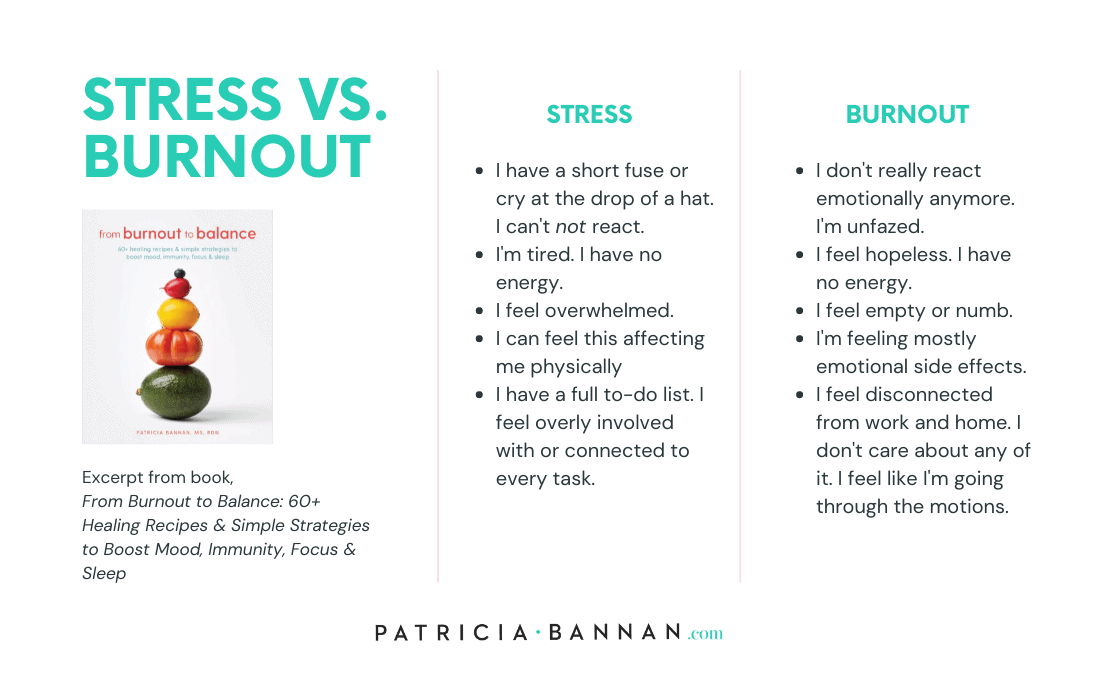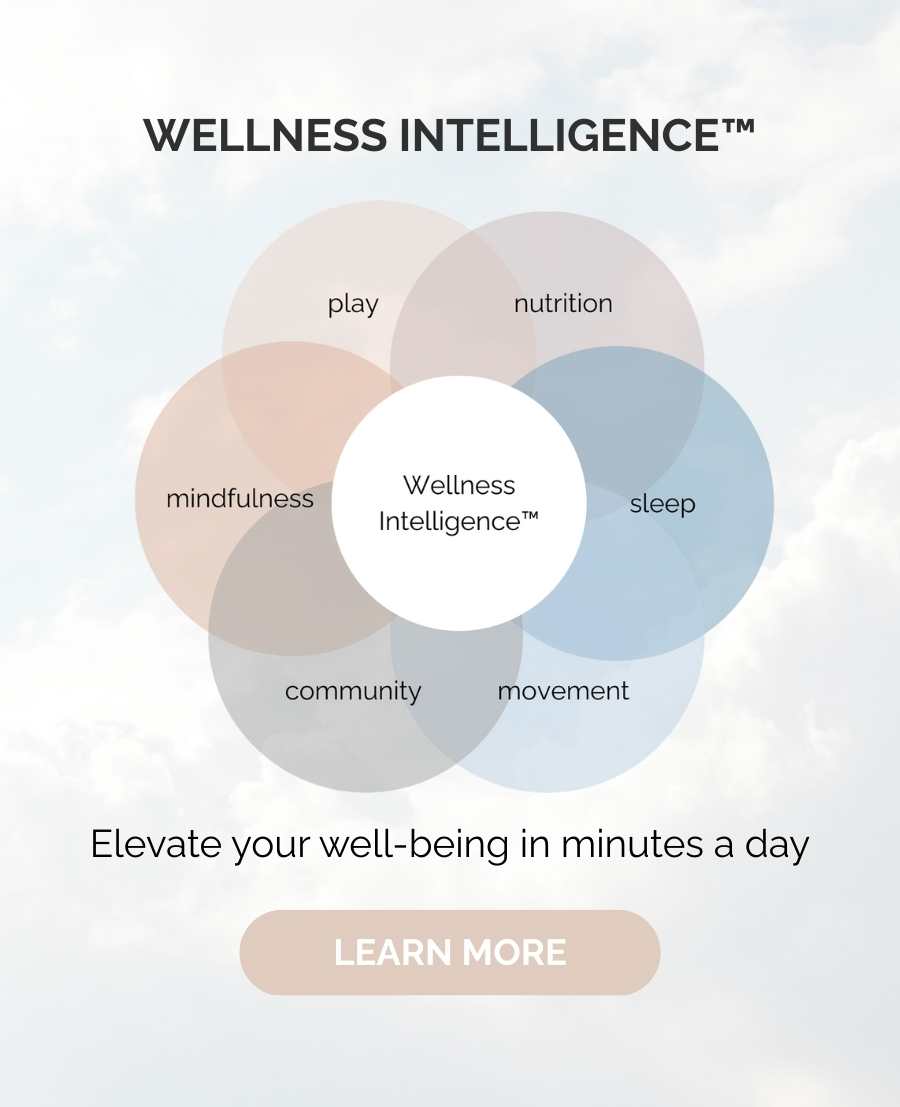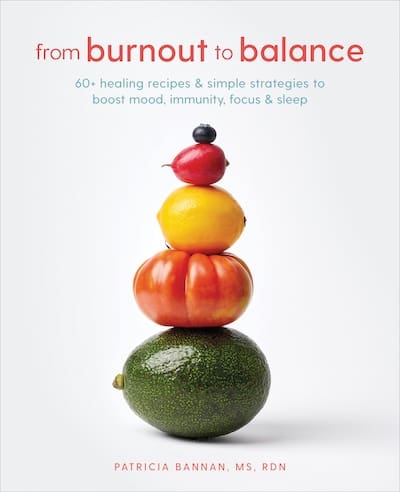Learn about stress vs. burnout and how they can impact your personal and professional lives, the main differences between the two, and key signs to look for.
This article contains excerpts from my book, From Burnout to Balance: 60+ Healing Recipes & Simple Strategies to Boost Mood, Immunity, Focus & Sleep.
The feeling is all too familiar – you’re feeling exhausted, overwhelmed, or like you simply can’t.give.any.more. Is this stress? Is it burnout? Did the stress lead to burnout? It helps to first understand the difference between the two.
Is It Burnout — or Just Stress?
While chronic, unrelenting stress can lead to burnout, the symptoms are different. That’s because burnout is stress that’s taken such a toll that you no longer feel like yourself.
While stress—even intense bouts of it—might motivate you to work harder and parent “better,” burnout makes you feel like you can’t function and no longer want to. Stress can and will take a toll on your physical and emotional health.
Think of it like going into debt because you keep putting everything on credit cards. Burnout is when you’ve maxed out those cards, drained your savings, maybe bounced some checks, and don’t have even a dime left to your name.
 The 3 Dimensions of Burnout
The 3 Dimensions of Burnout
Burnout was first measured on the Maslach Burnout Inventory, which divides burnout into three different dimensions:
- Emotional exhaustion: You feel stuck, trapped, like you have no control over your life due to chronic stress that has eroded your resilience.
- Depersonalization: You start to become detached from yourself and your life. You don’t care about things that used to bring you joy, and you feel less connection to people (even your kids or sweetheart) and your work.
- Lack of accomplishment: You take less pride in your work (both at home and at the office), and you begin to doubt that you know what you’re doing. You start doing less or scaling back, but not in a strategic way that will heal burnout.
While this burnout self-test was developed for occupational burnout, you can’t ignore that it happens in our personal lives, too. As a practitioner, I think it’s important we realize the holistic nature and enmeshed causes of burnout.
I often discuss the three pillars of burnout as: work stress, personal challenges, and personality type. If you’re like me, a type A perfectionist or people-pleaser, you’re likely more prone to burnout than your laid-back friend.
Positive and Negative Stress
Stress is a response to mental or emotional pressure. While most people consider stress to be negative, there are two types of stress: eustress and distress. Eustress refers to positive stress, and distress responds to negative stress.
Positive stress is often triggered by something that excites you that may be accompanied with some nervousness.
Positive stressors you may experience include:
- Having a new baby
- Buying a house
- Starting a new job
- Building your own company
- Moving to a new town
Distress on the other end, refers to feelings of overwhelm from situations such as:
- Constant disagreements with your partner
- Too much on your to-do list at work
- The demands of raising children
- Financial difficulties
- Conflict with family or friends
The Difference Between Stress vs. Burnout
There is a clear distinction between stress and burnout when it comes to the responses you have in certain situations.
Stress can build up over time and can impact you both emotionally and physically. Your to-do lists are never ending, and your body is taking a toll.
Burnout on the other hand, takes this a step further. You’ve surpassed the feelings of stress, to a point where you don’t have it within you to care anymore. You have a “just keep going” mentality to get through the day.
Here’s a comparison of stress vs. burnout.
 Burnout Symptoms
Burnout Symptoms
Not sure whether you’ve experienced burnout (or are experiencing it right now)? Here’s a quick checklist of common symptoms:
- Anxiety and/or depression
- Changes in productivity and work or home performance
- Constantly feeling tired or fatigued, for no known reason
- Feeling more negative than usual or isolated
- Getting sick more often than usual
- Irritability and feeling raw
- Loss of appetite or eating more sugary or carb-filled foods than usual
- No longer enjoying things you once did
- Physical symptoms like headaches, shortness of breath, chest tightness, stomach upset
- Rage and anger
- Shorter attention span and difficulty concentrating
- Trouble sleeping due to a racing mind, waking up throughout the night, or insomnia
How many of these describe how you’re feeling? If you have more than a few, you might be experiencing burnout.
Long term consequences of burnout can impact your heart health, lead to weight gain, and even potentially cause type 2 diabetes and metabolic syndrome. That’s why it’s so important to recognize burnout when it’s happening and to find realistic ways to help heal from it.
Difference Between Stress and Burnout in the Workplace
The workplace lends to a lot of circumstances that can add to your stress bank. Long hours, trying coworkers, poor management, lack of recognition for your accomplishments. These can all add to the feelings of overwhelm to complete your tasks and deadlines, even if you do finish everything on time. Stress in the workplace can show itself in many ways depending on your role. However, it is usually accompanied by feeling of anxiousness or overwhelm.
Burnout on the other hand, occurs when stress has taken such a toll that you can’t figure out where to start tackling your to-do list, and you are sometimes at a point of not caring if things get done. You may feel trapped in your role, detached from your coworkers and family, and/or no longer feel a sense of pride in your job. You may also notice that your overall performance is declining.
Mom Burnout
Mom burnout is another all-too-real syndrome that deserves a place in the spotlight. From feeding, managing activities, sudden tantrums, limited “me” time, and all the other tasks involved in a day with kids, sometimes it’s too much to take. You may feel extra irritable, exhausted, or detached.

Whether you have a significant other to help with childcare, or you are a single parent managing it all – both can be tough. That isn’t to say that having and caring for a child isn’t an amazing gift. But at the end of the day, if you’re experiencing burnout, you need to find a way to reboot your own battery.
One of the first steps in the right direction can be to find ways to ask for more help. Even starting small, this can free up a little bit of space in your mind to ease some of the burnout. Another tool can be to prioritize what really matters and let the rest go — including the guilt for not doing 100% all the time.
Working Mom Burnout
Adding to this line of mom burnout is working mom burnout. First and foremost, stay-at-home moms deserve a whole lot of credit. And there is no right choice in deciding to raise your kids full time or to separate your time between work and raising your kids. You made your decision based on what is best for you and your family, and it can change overtime.
However, the American workplace can be hardest on women, who are expected to work like they don’t have kids, and parent like they don’t have work. It’s impossible and it takes a toll on every aspect of our lives and well-being.
To help prevent working mom burnout:
- Let go of perfectionism
- Get as familiar as possible with your limits
- Build a strong support system
- Be present in the moment – set specific times to give your full attention to one thing or the other
- Find a job you enjoy and negotiate a salary that makes it worth it – if this seems out of reach, the first step is to recognize it’s something you want and start taking small steps to make it happen
Final Thoughts on Stress vs. Burnout & Where to Get More Help When You Need It
For a complete guide on how to heal from burnout, check out my book From Burnout to Balance: 60+ Healing Recipes & Simple Strategies to Boost Mood, Immunity, Focus & Sleep.
I’m also happy to provide you with my top resources for dealing with burnout, including links to blogs, podcasts, videos and more! If there is more you want to learn about burnout, I’m always listening. Feel free to leave a comment below!
Featured Recipes From My Book
Here is a sneak peek of some recipes in my book that taste delicious while also providing you with nutrients that can help you heal from burnout:


 The 3 Dimensions of Burnout
The 3 Dimensions of Burnout Burnout Symptoms
Burnout Symptoms



